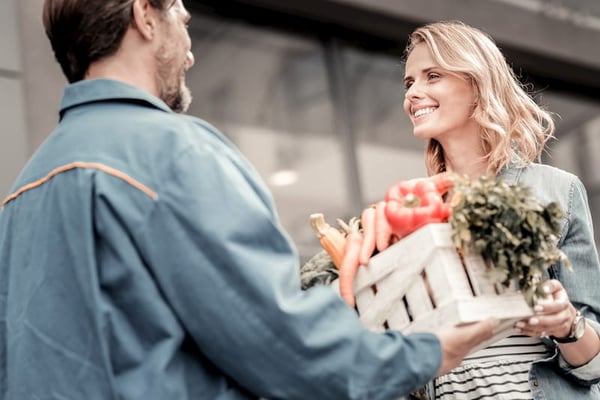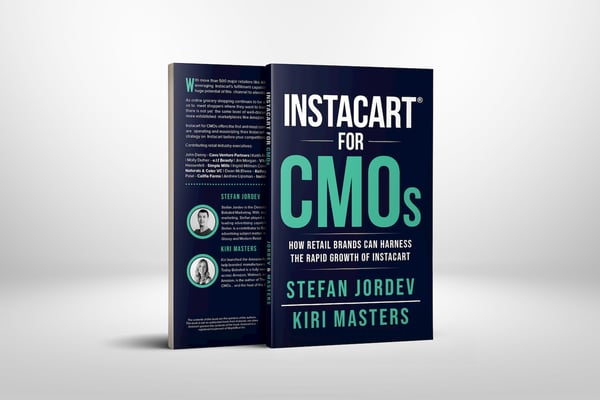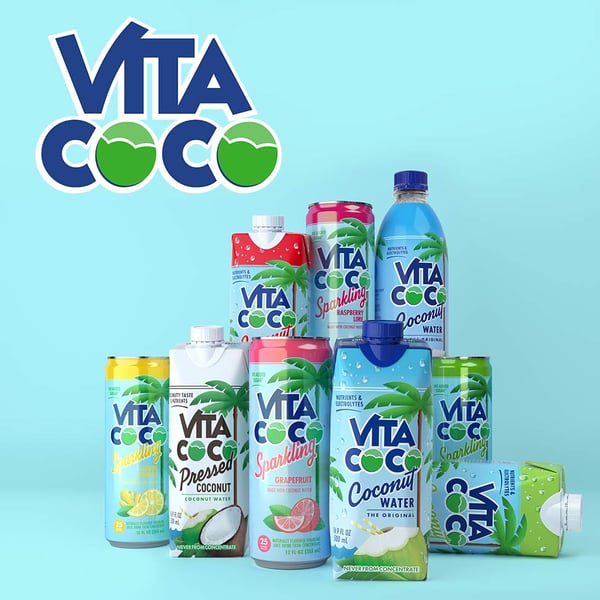In our upcoming book, Instacart for CMOs, we’ve shared hundreds of strategic insights about Instacart. The book includes contributions from leading executives from Clif Bar, Revlon and e.l.f. Cosmetics to name just a few.
To give you a little taste, we’ve cherry-picked several 2021-focused trends below. Enjoy!

🎉 Instacart for CMOs is live - order now on Amazon!
1) Expansion beyond grocery
Instacart took the opportunity to expand beyond the grocery category in 2020, announcing partnerships with Best Buy, Walmart, Staples, Bed Bath & Beyond, Buy Buy Baby, Sephora, and 7-11, among others.
Therefore, in 2021, it’s expected Instacart will lean heavily on their existing customer data and aggressively push non-grocery items on the platform.

“Loyal Instacart customers love the channel because of the convenience factor and the unprecedented range it provides. It’s perfect for the ‘big weekly grocery shop’ or when you desperately need a random item,” explains Kiri Masters, co-author of Instacart For CMOs.
“Many non-grocery items could be less expensive on Amazon.com or Walmart.com. But if users are opening the Instacart app several times a week browsing for groceries, it’s highly likely more people will give into convenience, and start consolidating their purchases to a single platform.”
Key takeaway: non-grocery brands need to grasp the Instacart opportunity right now in order to capitalize on the tangible ‘first-mover’ advantage (more on this below).
2) The vaccine won’t stop the growth of online grocery
Leading experts around the world agree – online grocery is here to stay.

A study by BGC shows that 35% of US shoppers new to e-commerce in March plan to continue making grocery purchases online after COVID-19 restrictions are over. By 2022, ecommerce’s share of individual grocery categories is expected to be as much as three times higher than pre-COVID-19 levels and two times higher than forecasts before the pandemic.
Brands holding out for a return to brick and mortar grocery domination are in for a very long wait. Jim Morgan, Head of Ecommerce & Digital Growth at Vita Coco and Instacart for CMOs contributor, had the following to say on this topic.
“I think all of these new consumers coming over to the platform (Instacart) are not going anywhere. Every piece of research I've seen is that, yes, the ones that came into online grocery for the first time are now buying more, and they're buying more often.”
3) More PPC Sophistication
Right now, the PPC tools on Instacart are fairly sparse. Despite the immaturity of the ad platform, across the board brands are reporting amazing ROI that exceeds results on both Amazon and Walmart. We have written more about the current state of advertising here – Instacart Advertising Overview For Grocery and CPG Brands.
Instacart has aggressive growth goals for its advertising business. A job advertisement for a Director of Data Science on Instacart’s website says, “In this position, you will work closely with senior product and engineering leadership to grow and drive Instacart’s ads revenue into a multi-billion dollar business, and also that the role would help Instacart to 5x our ads revenue over the next 2-3 years.”

Instacart clearly has the ambition to grow into a significant advertising platform. And while it has proven immense ROI in performance advertising, more leverage exists outside of just an algorithmic search advertising vehicle. There are a few ways Stefan Jordev, co-author of Instacart for CMOs, sees this shift unfolding.
- Instacart could make a play towards introducing more middle and top-of-funnel self serve advertising products. This is conceivable, given the nature of advertisers on its platform (mid to large brands). Advertising on Instacart is retailer-agnostic, and it would provide brands with a neat solution to shift a portion of their branding budget towards Instacart.
- On a related note - Instacart could build very creative, ‘editorial’ type ad units. In an interview, Vikaram Gupta, Instacart’s Vice President of Ads Engineering, says that longer term, he is “dreaming about how to bring more inspirational content into the ads.” This could manifest as CPG brands being able to publish recipes in collaboration with a celebrity chef, or a baby care brand that can share top tips for new Moms.
- More near-term, we believe that self-serve banners will be Instacart’s first top of the funnel solution released on the platform. During 2020, brands had the option to create banners campaigns working with Instacart’s support team. That’s often the sign of a feature that will be rolled out on a self-serve capacity.

Julie Liu, Omnichannel Shopper Marketing at Clif Bar & Company and Instacart for CMOs contributor, shared her experience with Instacart banner ads.
“Banners are a good way for us (Clif Bar) to get some awareness and exposure within the category for people who are browsing, and maybe also using that in addition to the search function. And so we definitely see that as more than awareness play versus direct sales driving.”
4) A Response From Retailers
Ultimately, more revenue for Instacart is more revenue for the retailers that sell on the channel. This is particularly important for retailers who do not have their own mature last-mile delivery play, as without Instacart they would be losing home-delivery sales right now. Larger retailers who are thinking strategically are likely to believe that they should eventually own the fulfillment process, or at least white-label it. But for many, that reality is very far off.
So, as it stands, retailers and Instacart are very much in a ‘frenemy’ type of relationship. Therefore, it’s highly likely over the next year more retailers will start thinking about how they can learn from, then ultimately compete with Instacart on their own terms.
Here are some examples of retailers who appear to be using Instacart as a means to an end.
- Walmart initiated a pilot with Instacart in late 2020, in four markets: Los Angeles, San Francisco, San Diego and Tulsa, Oklahoma. At the same time, Walmart has been building its own digital offerings, including “Express Delivery”, a 2-hour delivery service that it intends to roll out to 2,000 stores.
- Texan supermarket chain H-E-B has onboarded with Shipt, Instacart and some smaller delivery providers, ensuring they wouldn’t become overly reliant on any one player. In 2018, H-E-B acquired Favor, an on-demand delivery company.
- Target acquired Shipt to facilitate delivery of ecommerce orders from its stores. Against the current trend of building dedicated warehouses for fulfilment, Target has stated that most ecomm fulfillment is done through their stores.
Expect traditional retailers to start grappling with the shift in customer behavior directly in 2021. Some may land on a hybrid approach - their in-house solution for areas with high route-density, and Instacart for smaller cities where they cannot get the required scale for order density.
5) ‘First movers’ to achieve phenomenal numbers in 2021 and beyond
In order to win on Instacart years from now, you need to start playing today.
This is not simply a ‘get grandfathered in while you still can’ type of sentiment. It’s a strategic recommendation based on how the Instacart marketplace is designed to function.
Allow us to explain. Once a particular product gets in an Instacart user’s ‘past purchases’ basket, it is much easier to influence buyers towards a repeated purchase. Instacart also nudges its users to re-order items that have been added to their basket in the past.

In a webinar presentation to brand and agency advertisers in Q4 of 2020, Instacart said that a whopping 20-25% of shopping activity comes from repurchasing. This creates a constant validation loop of getting consumers to buy items that they already bought in the past which is incredibly beneficial for brands.
Hence, it really pays to be a first mover on Instacart. John Denny, VP at CAVU Ventures and Instacart for CMOs, had the following to say on this topic.
“I'm having conversations with CMO’s across our brands to help them understand what's going on here (Instacart). Right now there is a land grab going on for the first purchase of these initial consumers.”
Key takeaway: In 2021, brands that started taking Instacart seriously in 2020 are primed to see the compounding effect of these growing ‘past purchase’ orders really come into effect. For other brands, it’s not too late, but they find a way to start prioritizing Instacart today!

Tagged: PPC Advertising, Grocery & Gourmet Food, Beauty, Instacart
.png)


